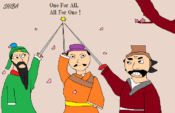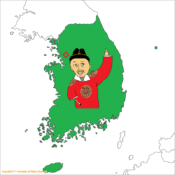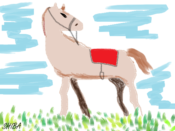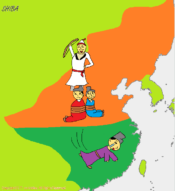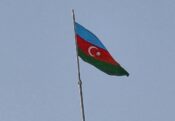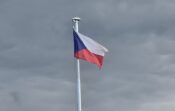4世紀~認められたキリスト教~ Accepted christianity
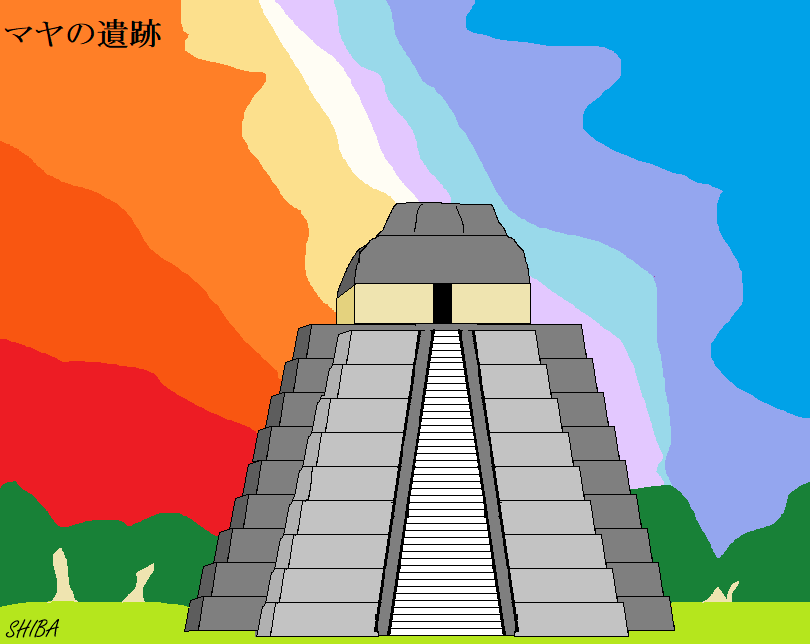
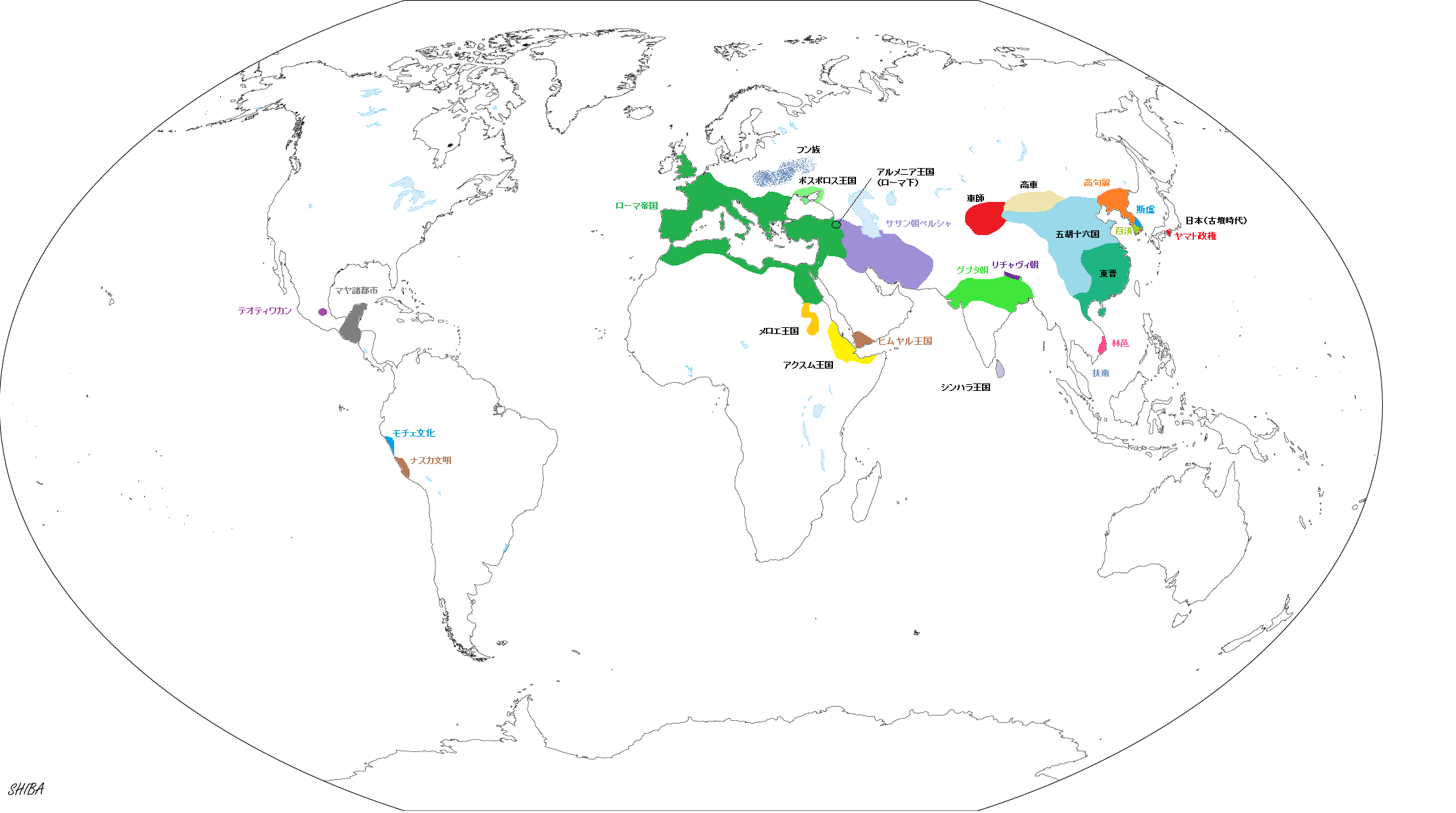
前(3世紀~三国志と邪馬台国~) ← → 次(5世紀~世界を揺るがした遊牧民族~)
ローマ帝国に混乱をもたらした軍人皇帝時代は、3世紀末、ディオクレティアヌスが皇帝に即位したことでようやく落ち着きます。彼は帝国を4つに分け、2人の皇帝、2人の副帝を各々置くことで、地方の独立勢力を抑えようとしました。
The era of “Barracks Emperors”, which brought chaos to the Roman Empire, finally subsided with the accession of Diocletian to the throne at the end of the 3rd century. He divided the empire into four parts, each with two emperors and two vice-emperors, in an attempt to suppress local independent forces.
ディオクレティアヌスはまた、キリスト教徒に大弾圧を加えた皇帝としても知られています。しかし彼の弾圧をもってしてもキリスト教は息絶えませんでした。それほどまでにこの宗教は人々に受け入れられ、信者を増やしていたのです。ついには君主達もこのキリスト教を認めるようになります。
Diocletian is also known who persecuted Christians. However, even with his persecution, Christianity did not disappear. The number of believers of this religion was so increasing. Eventually, the monarchs came to recognize Christianity.
もくじ
コーカサス・アフリカ Caucasus / Africa
キリスト化の最初はコーカサス山脈に位置するアルメニア王国でした。この国は当時ササン朝とローマ帝国が覇権を相争う係争地でしたが、逆に言えば双方の中心地から遠く、どちらにも染まらない半独立の国でした。
The first kingdom Christianized was Armenia, located in the Caucasus Mountains. At the time, this country was a disputed territory between the Sassanid Empire and the Roman Empire. In other words, it was a semi-independent country that was far from the center of both Empires and was not influenced by either.
301年、アルメニア国王ティリダテス3世は洗礼を受け、キリスト教を世界で初めて王国の国教としました。アルメニアはこの後もヨーロッパと西アジアの大帝国により次々と征服されますが、キリスト教(アルメニア教会)はその都度住民の支えとなり、現在まで続いています。
In 301, King Tiridates III of Armenia was baptized and adopted Christianity as its official religion first in the world. After that, Armenia was conquered one after another by the great empires of Europe and West Asia, but Christianity (Armenian Church) supported the population each time, and continues to this day.
またキリスト教はアフリカにも伝わっていました。現在のエチオピアにあったアクスム王国は、4世紀半ばエザナ王の時代にキリスト教を受け入れ、現在まで続くエチオピア教会の端緒を開きました。これに前後してアクスム王国は、北隣のメロエ王国(現スーダン)を滅ぼし、紅海を挟んだ対岸のヒムヤル王国(現イエメン)を支配下に組み込むなどして、東アフリカ随一の大国となります。
Christianity also spread to Africa. The Kingdom of Aksum, located in present-day Ethiopia, accepted Christianity during the reign of King Ezana in the mid-4th century, marking the beginning of the Ethiopian Church that continues to present day. Around his time, the Kingdom of Aksum became the largest power in East Africa, destroying the Kingdom of Meroe (present-day Sudan) and dominating the Kingdom of Himyar (present-day Yemen) on the opposite shore of the Red Sea.
ヨーロッパ Europe
ローマがキリスト教を受け入れたのは、313年コンスタンティヌス大帝の時代です。彼は事実上4つに分かれた帝国を統一した有能な人物でしたが、その際利用したのがキリスト教だったといわれています。旧来迫害の対象だった彼らを逆に取り込み、支持を得たのです。
When Rome accepted Christianity was in 313 during the reign of Constantine the Great. He was a capable man who unified the empire, which was effectively divided into four, and it is said that he used Christianity to do so. He gained support by incorporating people who had previously been subject to persecution.
キリスト教を認めると今度は、「何が正しいキリスト教なのか」が問題となります。キリスト教誕生からすでに300年近く経ち、様々な宗派が生まれていたからです。この問題をはっきりさせるため、325年ニケーア公会議が開かれ、「イエスは神の子である」というアタナシウス派が「正統」とされました。
Once Christianity was accepted, the next problem arose, “What is the orthodox Christianity?” This is because nearly 300 years have passed since the birth of Christianity, and various sects have sprung up. In order to clarify this issue, the Council of Nicaea was held in 325, and the thought of Athanasius who said “Jesus is the Son of God” was decided ”orthodox.”
一方、伝統に反する皇帝の考えに反対する人々も当然いました。コンスタンティヌスはこの後、帝国の都をビザンティウムに遷します。皇帝の名を採って改められたその都市の名はコンスタンティノープル、現在のイスタンブールです。ここはアジアとヨーロッパ、地中海と黒海の接点にあたる、交易の上で極めて重要な地です。
On the other hand, there were naturally those who opposed the emperor’s policies, which went against tradition. Constantine then moved the capital to Byzantium. The city was renamed “Constantinople”, that is now Istanbul. This is an important place for trade, as it is the junction between Asia and Europe, the Mediterranean Sea and the Black Sea.
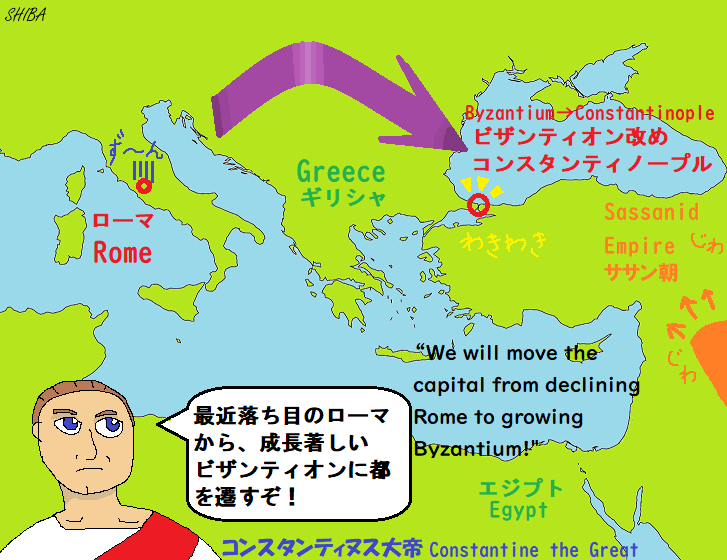
彼はローマに残る保守層を見限り、多様な人、モノ、そして思想が行き交うコンスタンティノープルで帝国の立て直しを図りました。
He gave up on the remaining conservatives in Rome and sought to rebuild the empire in Constantinople, where a variety of people, goods, and ideas came and went.
コンスタンティヌス帝の死後、またローマは分裂と統合を繰り返し、フン族などの遊牧民も侵入。この中でキリスト教は、別の皇帝によって再び弾圧されることもありましたが、最終的に市民権を得ることとなります。
After Constantine, Rome repeatedly divided and unified, and nomadic tribes such as the Huns invaded. Christianity was once again suppressed by another emperor, but eventually gained citizenship.
379年即位したテオドシウス帝は、ローマの伝統的な多神教を捨て、4世紀末ついにキリスト教を国教化しました。この後、帝都コンスタンティノープルやローマをはじめ、帝国内各地にキリスト教の大本山が作られます。
Emperor Theodosius, who ascended the throne in 379, abandoned Rome’s traditional polytheism and finally made Christianity the state religion at the end of the 4th century. After this, major headquarters of Christianity were established in various parts of the empire, including Constantinople and Rome.
しかしこのような政策はローマ帝国再建には若干遅すぎた感がありました。395年テオドシウス帝が没するとまたもや帝国が分裂。この後ローマが再統一されることはありませんでした。
However, this kind of policy was a little too late to rebuild the Roman Empire. After the death of Emperor Theodosius in 395, the empire was once again divided. Rome was never reunited after this.
西アジア West Asia
ササン朝ペルシャ帝国では、4世紀の大部分がシャープール2世の治世にありました。母親のお腹の上に王冠をかぶせられ、生まれた瞬間から王だったというこの人物は、ライバルのローマ帝国やその支配下にあるアルメニアやジョージアがキリスト教を受け入れたことに対し、逆にササン朝内のキリスト教徒を迫害。自国の宗教であるゾロアスター教をますます重んじるようになります。
The Sassanid Empire of Persia was under the reign of Shapur II for most of the 4th century. This man, who was a king from the moment he was born with a crown placed on his mother’s belly, persecuted Christians because the rival Roman Empire and the countries under its control, Armenia and Georgia accepted this religion. And he began to value their native religion, Zoroastrianism, more and more.
南アジア South Asia
インドではクシャーナ朝が衰退し、代わりにグプタ朝が大国化します。チャンドラグプタ1世によってガンジス流域に築かれたこの王朝は、沿岸部を支配下に組み込むと、今までのインド王朝同様、交易の中継地として栄えました。
In India, the Kushan dynasty declined and the Gupta dynasty became a major power in its place. This dynasty, founded in the Ganges basin by Chandragupta I, took control of the coastal areas and flourished as a trading hub, just like previous Indian dynasties.
文化面ではサンスクリット語による文学が多数作られ、カーリダーサなど優れた作家が出現しました。中国の仏僧法顕がインドへ向かって出発したのも4世紀末のことです。
In terms of culture, a large amount of literature was written in Sanskrit, and excellent writers such as Kalidasa appeared. In the end of the 4th century, Chinese Buddhist monk Faxian (法显) set out for India.
中国 China
中国では、3世紀末に西晋で起こった内戦(八王の乱)により、せっかくの統一が破られ、再び群雄割拠の状態に陥ります。内戦時、中国の北方にいた遊牧民が傭兵として起用されましたが、その後も彼らは中国本土に居座ることに。
At the end of the 3rd century, the civil war (the Eight Kings Rebellion: 八王之乱) broke out and destroyed Western Jin(西晋) dynasty’s unification. And it once again fell into a state of military division. During the civil war, nomadic tribes in the north of China were used as mercenaries, but they continued to remain in mainland China.
こうして中国北部では、遊牧民による短命な王朝が興亡を繰り返す戦乱期を迎えました。鮮卑や匈奴といった5つの主要な部族が、16もの国を成立させたことから、五胡十六国時代と呼ばれています。この不安定な状況が解消されるのは、鮮卑族の拓跋氏により386年に北魏が成立するのを待たねばなりませんでした。
Thus, northern China entered a period of war, with short-lived nomadic dynasties repeatedly rising and falling. It is called the period of “Sixteen Kingdoms” and they were mainly built by Five Barbarians such as Xianbei(鮮卑)and Xiongnu(匈奴).
This confusing time was resolved after the establishment of the Northern Wei(北魏) Dynasty by the Tuoba(拓跋) people of Xianbei in 386.
他方、中国南部では西晋の生き残りが東晋を建て、中国南北朝時代がここに始まります。
On the other hand, in southern China, the survivors of the Western Jin Dynasty established the Eastern Jin Dynasty, and the period of the Northern and Southern Dynasties began here.
政治的にはこのように流動的な中国社会でしたが、文化面でも大きな変化が起こります。それが仏教の広まりでした。インド生まれのこの宗教がシルクロードを通って中国にやってきたのは、漢の時代でしたが、当初は中国に滞在する外国人が仏教を信仰していました。
Chinese society was politically in flux, but culturally it was also undergoing major changes. That was the spread of Buddhism. This religion, which originated in India, came to China via the Silk Road during the Han Dynasty, and initially foreigners living in China practiced Buddhism.
しかし4世紀になると漢人(いわゆる中国人)の間にも信者が増えていきます。中国に1000近くの寺院を建設した僧侶仏図澄や、多くの経典を漢語に翻訳した鳩摩羅什は、中国における仏教の拡大に貢献した人物ですが、2人はいずれもシルクロード上にある亀茲 亀茲という都市国家の出身でした。
However, in the 4th century, the number of believers also increased among the Chinese people. Fotu Cheng(佛图澄), a monk who built nearly 1000 temples in China, and Kumārajīva(鳩摩羅什), who translated many scriptures into Chinese. Both were from the city-state of Kucha(龜茲) on the Silk Road.
朝鮮半島・日本 Korea / Japan
朝鮮半島では、韓族の3つの勢力から百済と新羅が抜きん出て大きくなっていきました。これらに北方の高句麗を加えた三国が、互いに勢力を競い合うようになります。また仏教も4世紀後半には朝鮮半島に伝わりました。
On the Korean peninsula, Baekje(百済) and Silla(新羅) stand out from the three Korean powers and grow larger. The three kingdoms, including Goguryeo(高句麗) in the north, began to compete with each other for power.
Buddhism also spread to the Korean peninsula in the late 4th century.
高句麗はまた、中国の漢が朝鮮半島北部に築いた楽浪郡と争っていました。313年高句麗の美川王は、ついにこれを滅ぼし、半島から中国の勢力を一掃しました。
Goguryeo was also in conflict with Lelang Commandery(乐浪郡), which was established by the Han Dynasty in China in the northern part of the Korean peninsula. In 313, King Micheon of Goguryeo finally destroyed it and wiped out Chinese power from the peninsula.
馬韓で最大の国となった百済では、346年に即位した近肖古王が371年高句麗を破り、漢山に都を置きました。現在のソウルです。新羅は厳密に言うとまだ斯盧という名でしたが、辰韓地域で最大の国となっていきました。
In Baekje, which became the largest kingdom in Mahan(馬韓), King Geunchogo who ascended the throne in 346 defeated Goguryeo in 371 and established the capital in Hansan. That is now Seoul. Silla was still called “Saro(斯盧)” at that time. And this kingdom became the largest country in the Jinhan(辰韓) region.
一時百済に敗れた高句麗ですが、391年に 広開土王が即位すると周辺地域を次々と征服し、高句麗の面積を史上最大規模にまで拡大します。
Goguryeo was defeated by Baekje, but in 391, when King Gwanggaeto ascended the throne, he conquered surrounding areas one after another, making Goguryeo’s area the largest in history. He also built stone monuments in the conquered areas.
当時倭国と呼ばれていた日本のことは資料が少なく不明点が多いのですが、この頃ヤマト政権が本格的に形作られたと考えられており、古墳も各地で造られるようになりました。朝鮮半島、特に百済との交流もこの時期に始まり、多くの渡来人が文字(漢字)や技術を伝えたと考えられています。
There is little information about Japan, which was then called “Wa(倭)”, and there are many unknowns, but it is believed that the Yamato government was fully established around this time, and ancient tombs began to be built in various places. Trade with the Korean Peninsula, especially Baekje, also began during this period, and many immigrants called “toraijin(渡来人)” were thought to have passed on writing and techniques.
アメリカ大陸 America
中米ではこの頃マヤ文明が隆盛し、コパン、ティカルといった大都市が発展したと考えられています。現在のグアテマラに興ったマヤ都市ティカルで、4世紀後半即位したヤシュヌーン・アヒーン1世は、現在のメキシコ中央部で長く繁栄していたテオティワカン出身でした。そのため彼はティカルにテオティワカン式の建築様式を取り入れ、この都市を発展させました。すでに中央アメリカに、広いネットワークが形成されていたことがわかります。
In Central America, it is thought that the Maya civilization flourished around this time, and large cities such as Copan and Tikal developed. Yax Nuun Ahiin I who ascended the throne of the Tikal (in present-day Guatemala) in the late 4th century, was from Teotihuacan, in what is now central Mexico. He introduced Teotihuacan architecture to Tikal and developed this city-state. It can be seen that a wide network had already been formed in Central America.

<主な出来事>
301 アルメニア王国、キリスト教受容(コーカサス)
309 シャープール2世即位(ペルシャ)
313 ミラノ勅令 コンスタンティヌス帝、キリスト教公認(ローマ帝国)
313 高句麗、中国の楽浪郡を滅ぼす(朝鮮)
316 永嘉の乱 西晋滅亡(中国)
318~320頃 チャンドラグプタ1世、グプタ朝開く(インド)
325 ニケーア公会議 キリスト教の正統派がアタナシウス派と決まる
330 ローマ帝国の首都 コンスタンティノープルに遷る(ローマ帝国)
350頃 エチオピアのアクスム王国、スーダンのメロエ王国を滅ぼす(東アフリカ)
372 高句麗に仏教伝来(朝鮮)
375 フン族侵入 ゲルマン民族の大移動始まる(ヨーロッパ)
376 チャンドラグプタ2世即位(インド)
379 ヤシュヌーン・アヒーン1世即位(マヤ文明)
383 淝水の戦い 東晋が前秦を破る(中国)
384 百済に仏教伝来(朝鮮)
386 北魏成立(中国)
392 テオドシウス帝キリスト教をローマの国教とする(ローマ帝国)
395 テオドシウス帝死去 ローマ完全に分裂(ローマ帝国)
301 Kingdom of Armenia, accepted Christianity (Caucasus)
309 Shahpur II ascended the throne
313 Edict of Milan Emperor Constantine recognizes Christianity (Roman Empire)
313 Goguryeo destroys Lelang Commandery (Korea)
316 Disaster of Yongjia: Fall of the Western Jin Dynasty (China)
Around 318~320 Chandragupta I established the Gupta dynasty (India)
325 Council of Nicea Athanasianism is decided as the orthodox Christian denomination
330 Capital of the Roman Empire moved to Constantinople (Roman Empire)
Around 350 Kingdom of Aksum destroyed the Kingdom of Meroe (East Africa)
372 Buddhism introduced to Goguryeo (Korea)
375 Invasion of the Huns; Migration Period began (Europe)
376 Chandragupta II ascended the throne (India)
379 Yax Nuun Ahiin I ascended the throne (Maya)
383 Battle of Fei River(淝水之战) Eastern Jin(東晋) defeated Former Qin(前秦)(China)
384 Buddhism introduced to Baekje (Korea)
386 Northern Wei(北魏) was established (China)
392 Emperor Theodosius made Christianity the state religion of Rome (Roman Empire)
395 Theodosius died; Rome is completely divided (Roman Empire)
前(3世紀~三国志と邪馬台国~) ← → 次(5世紀~世界を揺るがした遊牧民族~)
